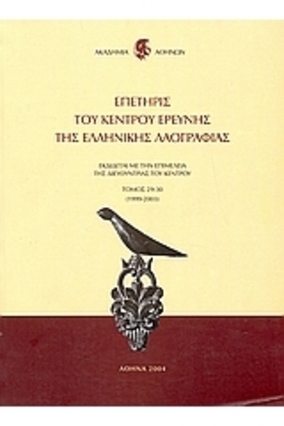Ή Βάση Δεδομένων γιά τά Παραμύθια : Προβληματισμοί καί μέθοδος
Part of : Επετηρίς του Κέντρου Ερεύνης της Ελληνικής Λαογραφίας ; Vol.28, 1986, pages 257-278
Issue:
Pages:
257-278
Parallel Title:
A Database for folktales : Concerns and method
Author:
Abstract:
The folktales database is part of a larger ptoject's framework aimed towards the electronic classification of the archives in the Hellenic Folklore Research Center. At the same time, this project responds to the growing scientific and publishing interest in folktales. In fact, folktale research in Greece has a considerable volume of material: The recorded variants of tales in the greek language amount to several thousand, a constantly rising number, as the collection of original material continues until today. The difficulties faced by the researcher are encountered in the ability to have a systematic primary source search and accessibility, according to special criteria. This particular work meets the fore-mentioned requirements and at the same time, secures protection of the original frim usage by introducing the manuscript's image in electronic form. Although there have been clear instructions on ethnographic methodology and ethics among the first folklorists (especially N. G. Polites and G. A. Megas), the collection of this material was often conducted in an amature way by non-specialists, basically up to the '60's decade. As the collector's primary goal was to preserve the oral text itself —not necessarily its cultural contextrecordings of many folktales lack clarifying ethnographic elements, mainly regarding the narrator and the narration itself, not to mention its transmission and re-composition mechanisms. We believe that a big part of methodology shortcomings in the first field recordings can be filled with an elemental recollection of the cultural context, according to the information often given through other incentives in the manuscript. An important prerequisite for the material's management is the manus cripts' progressive cataloguing process in order to estimate the exact number of folktales they contain (9.000 variants have been found among the 67% of manuscripts catalogued up to this point). These archive variants are then introduced to special electronic cards, where data is arranged into concrete fields of general interest and interactive fields of a more specialized interest. In the basic (concrete) fields, all information necessary to select a certain variant according to its source, area of recording, and other classification data based on the Aarne-Thompson typology, is constatly on display. For recordings made up to the '70's decade, the classification suggested by G. A. Megas in his upublished catalogue is adopted. As for the interactive fields, a more specialized form of information is given to cover the following aspects: — A variant synopsis with its title, summary and key-words, allowing thematic research by field and by general category of ethnographic interest. — Comments made by the Center's researchers and collectors, during all stages of material elaboration. — Information about the collection referring to the informer's identity as well as the particular idiom of the recording. — Information on previous cataloguing information for each variant. — A visual form of the original manuscript. Furthermore and equally important with data analysis, is the possibility of reconstruction during the search, based on specific criteria as they are formed by different fields in each electronic card.
Subject:
Subject (LC):




